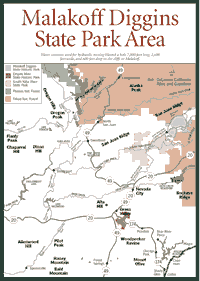 Malakoff
Diggins State Historic Park
Malakoff
Diggins State Historic Park[Fig. 15, Fig. 16, Fig. 17] The Tahoe National Forest, designated in 1907, has 400 miles of hiking trails in 1.2 million acres and a cultural history that includes gold miners, hydroelectric power companies, timber companies, and pioneering families in California. The Tahoe is where the ill-fated Donner party spent the harsh winter of 1846, and many of the settlers died in the Sierra's frigid grip.
A few years after the Donner disaster, frontier families streamed through Donner Pass to pursue the gold rush. Their lives and their work are detailed in foothill-area museums and other attractions.
The American River, the main watershed in Tahoe, has been dammed at several places to provide hydroelectric power for growing cities, such as Sacramento. The alpine areas of the Granite Chief Wilderness overlook the forest from the east. The granite peaks of Mount Mildred at 8,398 feet and Granite Chief at 9,006 feet bear the scratches and scrapes of passing glaciers.
On the map, the Tahoe National Forest has a checkerboard appearance—some private ownership, some public ownership. Its history is filled with private land ownership by railroads, power companies, and logging firms. The legacy continues today with many acres of land still privately held within the forest boundaries.
 Malakoff
Diggins State Historic Park
Malakoff
Diggins State Historic Park[Fig. 15] The cliff at Malakoff gives dramatic evidence of the hydraulic mining done in years past. The cliff's sediments were stripped with powerful streams of water as gold miners searched for precious metal. The cliff is preserved, and state officials are trying to revegetate it slowly.
Visitors can still see a 7,847-foot bedrock tunnel that served as a drain for all the water. The miners used the tunnel as a drain for water brought in from Bowers Lake 15 miles away. More than 50 miles of canals were built to take advantage of the water.
A lot of natural habitat was lost in the hydraulic mining. From the beauty of the trees in the area today, it is not difficult to imagine what was lost. Visitors will find blue oak (Quercus douglasii), valley oak (Quercus lobata), redbud (Cercis occidentalis), California buckeye (Aesculus californica), digger pine (Pinus sabiniana), and canyon live oak (Quercus chrysolepis).
The digger pine is particularly well suited to serpentine soils often found in the area. It also is able to survive in dry conditions, growing sometimes in rocky conditions that would not work at all for oak trees.
Long before the hydraulic mining and before the time of the trees, volcanic ash showered the gold-bearing streams in the Sierra from 60 million years ago until about 9 million years ago. The ash came first from rhyolite explosions that began to subside about 20 million years ago. They were followed by andesite eruptions along vents in the Northern Sierra, such as Castle Peak and Mount Lincoln.
Lava flows rolled down the streambeds, creating layers above the gold and other minerals as well as diverting streams in foothill areas of the gold country.
The ancient streambeds and the volcanic activity that altered them are important in the story of Malakoff. The lava made the streambeds less resistant to erosion. With time and weathering, especially from 60 million years ago to 33 million years ago when the climate was more tropical in California, everything around the streambeds eroded, and the streambeds became elevated.
The elevated ancient streambeds became targets for enterprising miners between the 1860s and the 1880s. Using water cannons, the miners blasted through millions of years of sediments to find $3.5 million worth of gold at Malakoff. The effort produced 50 million tons of tailings that washed down the Yuba River.
Farmers downstream finally stopped the miners from the practice of washing away mountains. The farmers filed a successful legal action, which limited hydraulic mining by requiring containment of the tailings.
The water cannons left a hole 7,000 feet long, about 2,600 feet wide, and 600 feet deep in the cliffs at Malakoff. In all, similar hydraulic mining took more than 1 billion tons of sediment, rock, and debris from Sierra foothills.
[Fig. 15] For more than 100 years, Empire Mine in Grass Valley was one of the largest, deepest, longest operating, and richest gold mines around, producing nearly 6 million ounces of gold. The park contains many of the mine's buildings, the owner's home and restored gardens, as well as the entrance to 367 miles of abandoned and flooded mine shafts. There are 10 miles of trails in the park.
In June 1850, George McKnight discovered a gold-bearing quartz outcropping about 1 mile from St. Patrick's Church in downtown Grass Valley. Then, in October 1850, a lumberman named George Roberts found flecks of gold in a surface outcropping of quartz where the park's main parking lot is now.
The mine claim changed hands several times in the coming years, finally winding up in the hands of William Bourn Jr., the son of a capitalist. Bourn pursued the expansion of the mine.
The most important factor in the success of hard-rock mining in California was the immigration of skilled miners from Cornwall, England, where hardrock tin and copper mining had been carried on for more than 1,000 years. Cornish miners drilled, blasted, and mucked out most of the 367 miles of tunnels—some of which angled downward into the earth some 11,000 feet, nearly a full vertical mile below the surface.
By the time the mine shut down in 1956, the mine had produced more than $2 billion worth of gold at 1990s prices.
[Fig. 15] The longest single-span covered bridge in the United State can be seen at South Yuba River State Park. The bridge is more than 230 feet long. The parkland runs for miles along the steep, rugged canyon of the South Yuba River, providing beaches and picnic areas. The park also offers the Independence Trail, which is wheelchair accessible.
Docent-led history, nature, and gold-panning tours take place at various times of the year. More than 600,000 people visit the park each year.
Anyone who walks through the foothills in wild areas such as the South Yuba River should be aware of the western rattlesnake (Crotalus veridis). Though sightings of it are not common, particularly this far north in the Sierra, the snake is present in this area. Most often, the rattlesnake is seen in springtime.
The rattlesnake, the only poisonous reptile in the Sierra, usually is either hibernating or hidden beneath rocks or in grasslands along trails. It is cold-blooded, meaning it has no internal heat regulation. In spring, it warms itself in the sunshine when temperatures reach 65 to 70 degrees Fahrenheit.
The rattler is known for its tail, which can rattle into a buzz when the snake is provoked. It does not always rattle its tail, however. The snake's 2-inch fangs normally do not strike higher than 1 foot off of the ground, because the snake cannot jump. High leather boots are advised, especially in spring. Stay on the trails and watch where you step if you must leave the trail.
Winter is probably the biggest reason people live in Truckee and other cities in the Tahoe National Forest. People enjoy the milder months, but most cannot wait for downhill and cross-country skiing, snowboarding, and snow play.
It is not apparent to most visitors until they look at a map, but the winter recreation areas are not all in the national forest. The map looks like a checkerboard of public and private property.
Of the 1,208,993 acres within the boundary, 811,740 acres, or 67 percent, are National Forest System lands. The other 397,253 acres are owned by private individuals, corporations, or other governmental agencies. In most cases, these lands have been privately held since before the creation of the national forest.
The large, downhill ski complexes include Alpine Meadows, 3 miles west of Highway 89 south of Truckee, (530) 583-4232; Boreal Ski Area, on Interstate 80, (530) 426-3666; Soda Springs Ski Area, Interstate 80, (530) 426-3663; Donner Ski Ranch, Norden, (530) 426-3635; Sugar Bowl, Norden, (530) 426-3651; and Squaw Valley, 2 miles off Highway 89 South, (530) 583-6985.
Squaw Valley has the most ski facilities with 10 double chair lifts, 9 triple chairs, 4 high-speed detachable quads, a gondola, and 3 pony tows. The other ski complexes vary in their operations, with Alpine, Boreal, and Sugar Bowl offering more facilities than the others.
Privately operated cross-country ski facilities and tours include Alpine Skills International, Norden, (530) 426-9108; Eagle Mountain Resort, Interstate 80 at the Yuba Gap, (530) 389-2254; Royal Gorge, Soda Springs, (530) 426-3871; and Lakeview Cross Country, Tahoe City, (530) 583-9353.
Most of the cross-country operations, as well as the downhill resorts, offer groomed trails, lessons, and rentals. Lakeview Cross Country also has cross-country skating lanes. For snowmobilers and cross-country skiers who want to get away from the resorts, there are four areas designated by the state as Sno-Parks. A $5-per-day permit allows winter enthusiasts to snowmobile, cross-country ski, or build snowmen, ride sleds, and throw snowballs.
The areas include Yuba Pass, Yuba Gap, and Donner Summit, all of which are along Interstate 80 west of Truckee. For information about any of them, call the California Department of Parks and Recreation, (916) 324-1222.
In the southern part of the forest, China Wall Off-Road Vehicle Staging Area doubles as a kickoff point for winter recreation. The area, 14 miles east of Foresthill on Foresthill Divide Road, has plenty of parking, vault toilets, and trailhead access.
Cross-country skiers will not find groomed trails, but the skiing is easy because the terrain is level. The trails from the staging area will take skiers to the Mitchell Mine, Humbug Ridge, or Mumford Bar trailhead.
For snowmobiles, there is a 16-mile route up the divide corridor to Robinson Flat. From there, the trip winds north toward Soda Springs and Norden, which is about 40 miles away. At intermediate distances—12 to 14 miles away from Robinson Flat—are American Hill, Tadpole Meadow, and Sailor Flat. These destinations are along unplowed roads.
For those interested in the beginnings of skiing in this area of California, the Western Skisport Museum is at the Boreal Ridge Ski Area, 9 miles west of Truckee on Interstate 80. There is no fee, and films about the development of the sport in the northern Sierra are shown by request. The museum is open Tuesday through Sunday during the ski season and Wednesday through Sunday during summer.
The displays guide visitors through the early resorts and skiing in the area, dating back to the 1930s. The winter of 1932-33 was the first season that Highway 40 was kept open after lobbying by the Auburn Ski Club.
[Fig. 16(5)] Elisha Stevens, an old trapper, led a party of 46 men, women, and children out of Council Bluffs, Iowa, in 1844 on the first wagon trail through the Sierra Nevada, traveling through the present-day Tahoe National Forest. They traveled the Overland Emigrant Trail, where visitors today can drive and hike to see what the pioneers saw.
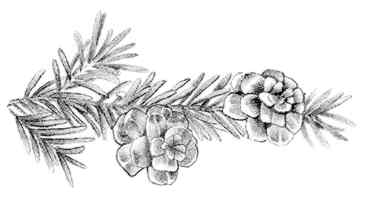 The
drama of Stevens's journey was somewhat obscured by the tragedy that unfolded
two years later when the Donner party trekked the same route and encountered
an October blizzard. The Donner party was split up and stranded, and many
died.
The
drama of Stevens's journey was somewhat obscured by the tragedy that unfolded
two years later when the Donner party trekked the same route and encountered
an October blizzard. The Donner party was split up and stranded, and many
died.
The Stevens party came through the area—Tahoe Forest's portion of the 2,000-mile Emigrant Trail—at a time when no one was quite sure how to cross the Sierra in a wagon train. Scaling granite escarpments and wooded slopes of the eastern Sierra, Stevens's group struggled through a series of canyons and rugged ridges on the western slope.
The group was guided by a Paiute Indian named Truckee, for whom the city of Truckee is named. The travelers established the forerunner of the major routes built through this part of the Sierra, including Interstate 80 and old Highway 40.
Even though about half of the Donner party died in the winter of 1846-1847 at Donner Camp, just north of Truckee, wagon trains poured through the area. More than 500 wagons came through the year after the Donner party. In 1852, more than 50,000 emigrants passed through Big Bend, about 15 miles west of Truckee.
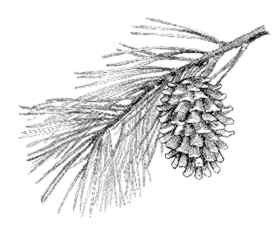 Emigrant
John Markle wrote about the trail in 1849, calling it "the damedest
[sic], rockiest, and roughest road I ever saw." Travelers had
to spend days unhitching their teams and carefully letting the wagons down
over massive granite boulders as well as fording cold, rushing streams.
Emigrant
John Markle wrote about the trail in 1849, calling it "the damedest
[sic], rockiest, and roughest road I ever saw." Travelers had
to spend days unhitching their teams and carefully letting the wagons down
over massive granite boulders as well as fording cold, rushing streams.
This trail later became the blueprint for a portion of the transcontinental railroad. In the 1860s, the Central Pacific Railroad charged a toll on an improved Emigrant Trail, which had been renamed Dutch Flat and Donner Lake Wagon Road.
By 1870, the railroad was constructed, and the wagon road was abandoned. Forty-three years later, in 1913, the Lincoln Highway opened as the first paved automobile route across the country, and it passed through the Emigrant Trail corridor. In 1930, it was replaced by Highway 40, or "Old 40" as it was called. By the mid-1960s, the modern, high-speed Interstate 80 emerged to replace "Old 40."
With all the transportation history, it might be easy to overlook the geologic background of this northern Sierra area. The granitic surface around Donner Summit, which is more than 7,000 feet high, dates back more than 80 million years.
Cretaceous river channels are preserved at Donner and at Paradise Lake, north of Donner. A pluton beneath Emigrant Gap, west of Donner Summit, has been estimated to be 10 miles across and more than 160 million years old.
Some of this rich geologic history can be traced on the road cuts along the modern interstate. The tilted layers of metamorphic rock between Auburn and the Emigrant Gap are believed to have been part of the ancient Sierra before the final pulses uplifted the mountain range over the last several million years. The metamorphic rock is representative of a time about 60 million years ago when the Sierra's climate was more humid, and the low, rolling hills were crossed by large rivers.
Road cuts at Dutch Flat, just west of Blue Canyon along Interstate 80, reveal gold-bearing gravels. They stand out even to motorists passing at 65 miles per hour, because the gravels have been turned red by weathering processes.
Beyond Emigrant Gap, granite is the main story. The granite, scarred by glaciers that passed through over the past 2 million years, is dotted in places with parts of older rocks that were caught in the plutons as they rose through the earth's crust.
Ridgelines on the eastern side of Donner Pass are coated with volcanic debris from eruptions that took place over the last 20 million years. The weathering processes have opened windows into a more distant geologic past, revealing other metamorphic layers that are perhaps more than 150 million years old.
Mingled with the geology is a diverse mixed conifer forest and wildlife. The forest varies from ponderosa pine (Pinus ponderosa) and white fir (Abies concolor) to mountain hemlock (Tsuga mertensiana) in the higher, subalpine belt on ridgetops around Donner Pass.
The wildlife includes the acrobatic mountain chickadee (Parus gambeli), a bird that curiously hangs upside down to capture insects for nourishment. The chickadee spends all day searching for food in the open woods around evergreens and oaks. Other birds include the winter wren (Troglodytes troglodytes), black-backed three-toed woodpecker (Picoides arcticus), junco (Junco oreganus), and purple finch (Carpodacus pupurens).
The area is also known for migrating birds. The Hammond flycatcher (Empidonax hammondi), the calliope hummingbird (Stellula calliope), and the hermit thrush (Hylocichla guttata) fly south to places such as Guatemala to spend the winter. They leave because the cold weather would deprive them of their insect diet. Look for them in summer, but they are gone by October when the nights cool down.
The Interstate 80 corridor is the best place to start exploring this area. The historic Overland Emigrant Trail is shown on a map sold by the U.S. Forest Service. The trail is about 35 miles long and suitable for driving in several places, but some sections must be hiked. It could take two days to complete.
The trip is broken into four distinct segments with a total of 19 stops, so it is not necessary to traverse the entire trail. It begins with the Ascent, between Dog Valley to the east of the Sierra crest, and the Donner Memorial State Park and Museum. The second segment contains three main passes over the crest. The third runs from Summit Valley to Alpha-Omega Rest Stop. The fourth is the run to the foothills from Deadman's Flat to Steephollow Crossing.
Plan before attempting the trip. It is best to find overnight accommodations at campgrounds or motels in Truckee, Colfax, or Soda Springs, which are along the route. Buy a map from the Truckee Ranger Station of the Tahoe National Forest.
The George and Jacob Donner Picnic Site, which can be reached by turning north onto Highway 89 from Interstate 80 and driving 2.5 miles, is where 14 people died in the cruel winter of 1846-1847. The first blizzard of the season caught the weary travelers in October, long before they expected to see snow fly.
George and Jacob had turned off the Emigrant Trail into the Alder Creek valley to repair wagons. A larger contingent of their party moved on, though they were hit just a few miles farther down the trail by the same blizzard.
The 25 people in Alder Creek valley quickly ran out of food and had no chance of moving through the deep snowdrifts. They had little chance to even build crude structures. They huddled in tents and cut trees to burn for warmth. Tree stumps found in later years were measured at 12 feet, indicating the depth of the snow.
Jacob was dead by December. George and many of the adults also died, denying themselves food so their children would survive.
The interpretive signs on the 400-yard walk around the area say the emigrants boiled the hides of their dead animals and ate the gluey mess. They do not confirm rumors of cannibalism, but they do raise the question.
At Donner Memorial State Park and Museum—return to Interstate 80, drive 4 miles west to the Donner Lake turnoff—the story of the rest of the wagon train is told. Those travelers, too, were caught in the blizzards of 1846-1847, and they suffered many deaths as well. A slide show and exhibit at the museum tell the whole story.
The park is near a prime recreation spot: Donner Lake. The park has no boat-launching ramp, but a public ramp operated by the Truckee Donner Recreation and Parks District is available in the northwest corner of Donner Lake. A fee is charged for boat launching. For information, call (530) 582-7720. The lake is open to both power and sail boats. Donner Lake Village Resort, 15695 Donner Pass Road, Truckee, CA 96161, has lakeside rooms. For information, call (800) 621-6664.
The park also has over 3 miles of frontage on Donner Lake and Creek. Fishing is not usually spectacular, though there are rainbow trout (Oncorhynchus mykiss) and some brown trout (Salmo trutta) in the lake. The lake is stocked with trout and a fishing license is required.
Other activities at the park include camping and hiking. The campground has 150 sites and a day-use area along the lake with picnic tables, restrooms, a beach, and a lakeside interpretive trail that has 18 panels that discuss the nature and cultural diversity of the area.
The Emigrant Trail Museum at the park takes about an hour to visit. It depicts the history of the area and the people who came into this part of the Sierra. Postcards, posters, maps, and books about the human and natural history of the area are for sale at the museum. There is an entrance fee.
Near the museum are the Pioneer Monument and the Murphy family cabin site. Also starting from the side of the museum is a self-guiding nature trail that is a 0.5-mile loop. Nature trail guides are available at the museum and campground entrance station. Guided hikes, ranging from one to two hours, start at the museum at 10 a.m. The hikes, special feature shows, and campfires start in late June and continue until late September. For specific information on any of the activities, call the park at (530) 582-7892.
Several miles west of the Donner park, Big Bend is another historic part of the Emigrant Trail where visitors can actually see rust marks that wagon wheels left on the granite. Captain John Fremont led a U.S. Army mapping detachment through Big Bend in 1845, the year before the Donner tragedy. Though this was still a Mexican territory at the time, Freemont was scouting for valuable resources.
To find Big Bend, drive west on Donner Pass Road from the state park for 2.25 miles, about 0.3 mile past Rainbow Lodge. Pull into a gravel turnout on the right just short of a granitic knob and walk 70 yards toward Interstate 80, which should still be well within earshot. Dozens of faint rust marks are apparent in the area.
Some of the most obvious rust marks from the iron wagon wheels can be found at Loch Leven trailhead, 0.25 mile east of the Big Bend Visitor Center on Donner Pass Road, farther down the road from the granitic knob. Walk down toward the Truckee River and you will find an iron "T" marker placed by Trails West. You are on the Emigrant Trail at that point. To contact the Big Bend Visitors Center, call (530) 426-3609. Tours of the Emigrant Trail can be arranged on weekends between Memorial Day and Labor Day.
Just a few yards upstream of the marker, walking east, you can find rust marks on the side of the rocks, caused by side scraping from thousands of wagon wheels. The rusted spots feel smoother because of the polishing done by the many passing wheels.
[Fig. 16(4)] The views from the Sierra crest are magnificent, and this trail is not a difficult day for many hikers. It allows hikers to quickly get to the top of the mountain range where views stretch seemingly forever.
The red face of 7,841-foot Red Mountain is apparent from the rooftop at Mount Judah. The reddish color comes from the metamorphic rock. In the distance is Mount Rose, the volcanic peak that, at 10,776 feet high, rivals the granitic domes in this Northern Sierra region.
Hikers can look for evidence of winter in the trees on the ridgetops and near the peaks on this trail. For instance, winds up to 50 miles per hour regularly whip through the canyons and over the summits in the Sierra, stripping the needles and branches on the windward side of lodgepole pine (Pinus murrayana) or white fir (Abies concolor).
The lodgepole particularly will sprout from granite cracks and crevices in a ridge, then bend as young saplings. When the saplings grow into mature trees, often their trunks will have a curved or "pistol butt" appearance.
[Fig. 16(2)] Two thousand years ago, the Washoe Indians lived in this small Northern Sierra valley. Their simple, unobtrusive lives had little impact on the ecosystem. Though the tribe is still in the area, a majority of the Washoe departed the area in 1850.
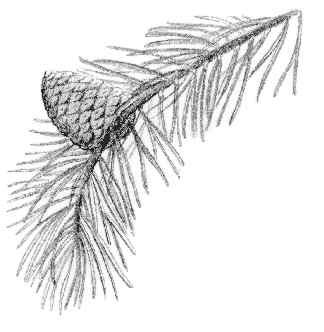 They
left behind petroglyphs similar to the ancient carvings found in other parts
of the northern Sierra. The rock carvings contain a type of petroglyph called
cupules, small round pits that have been forced into the rock.
They
left behind petroglyphs similar to the ancient carvings found in other parts
of the northern Sierra. The rock carvings contain a type of petroglyph called
cupules, small round pits that have been forced into the rock.
Cupules are believed to be part of the many ceremonial rituals of Native Americans. The rituals involved weather control or fertility rites.
For best viewing, see the cupules in the late afternoon. The lower light picks up the subtleties in the rock. Visitors will notice the cupules rock has been cracked in three sections. Do not touch it or attempt to make casts of it.
The cupules rock is the first stop on a walking or driving tour of the Kyburz Flat Interpretive Area. Signs give direction and history in a 3-stop tour that should take less than an hour to drive.
The second stop illustrates a typical 1860s stage stop. The Gold Rush changed the face of transportation in the area in the mid-nineteenth century. Entrepreneurs built a network of roads and started stage and freight companies to serve new mining communities.
The archaeological remains of More's Station—occupied by Lysander More and his family—are visible at this site. Signs mark different features of the 320-acre site, which was complete with a hotel, barn, and stables. The signs, interestingly, locate a root cellar used for cold storage.
The last stop in the interpretive area is Wheeler Sheep Camp, where visitors can see the brick oven where bread and stews were made as long ago as 1927. The oven is a reconstruction of the old equipment that collapsed in the 1980s.
Fresh bread—sheepherder's bread—was supplied to the herders every five days. Decades later, this type of bread is a popular item found in many grocery stores in the western United States.
The camp, with a three-bedroom cabin and tent platforms, was built by the Wheeler Sheep Company, which grazed sheep in the high Sierra during the summer. The camp was owned by John Martin Gallues, a Basque immigrant. He and his brother, Felix, built several of the structures themselves. The camp included sheep corrals, chutes, and livestock scales.
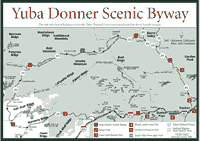 Yuba
Donner Scenic Byway
Yuba
Donner Scenic Byway [Fig. 16(1)] Historic Kyburz Flat is only one stop on the Yuba Donner Scenic Byway, a 160-mile loop of highways crossing the Tahoe National Forest. The transportation history, recreational opportunities, and sites of interest extend into four Sierra Nevada counties—Nevada, Placer, Sierra, and Yuba.
The scenic byway takes visitors to gold and silver mining museums and railroad sites. It goes north from Truckee on Highway 89 to Highway 49 where it turns west and then south to Highway 20. From there, it continues east to Interstate 80 and back to Truckee.
Along the byway are many towns, museums, and walking tours. For walking tours, call individual cities: Forest City, (530) 288-3231; Downieville, (800) 200-4949; Grass Valley, (530) 273-4667; Nevada City, (530) 265-2692, and Truckee, (530) 587-2757.
Call individual museums for more information: Firehouse Museum, Nevada City, (530) 265-5468; Grass Valley Museum, Grass Valley, (530) 272-4725; Historic Library, Nevada City, (530) 265-5910; Nevada County Historical Society Video History Museum, Grass Valley, (530) 274-1126; North Star Mining Museum, Grass Valley, (530) 273-4255; the Downieville Foundary, (530) 289-3261; the Alleghany Mining Museum, Alleghany, (530) 287-3330; Kentucky Mine Museum, Sierra City, (530) 862-1310; Loyalton Museum, Loyalton, (530) 993-6754; and Pelton Wheel Exhibit, Camptonville, (530) 288-3231.
[Fig. 16(3)] Though private property seems to be everywhere in the Tahoe National Forest, there are bike trails where it is acceptable for the public to go. One such trail is off of Interstate 80, along the Yuba Donner Scenic Byway. It is called the Lower Lola Montez Trail, and it is moderately difficult.
From the trailhead, bikers follow the trail north for 0.25 mile to a road and turn right. The road goes to lower Castle Creek crossing. The creek is lined with mesh wire, so be careful to avoid a flat when crossing.
The trail goes up and down, passes through an open mountain meadow, and winds past Lower Lola Montez Lake, a wonderful swimming and camping location. There are a lot of hikers on weekends, so control the speed of descent on this trail. Because there is private property in the area, bicyclers are advised to stay on the trails.
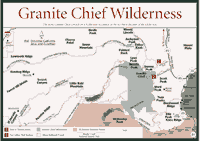 Granite
Chief Wilderness
Granite
Chief Wilderness [Fig. 17] This not the best place to find a lake for fishing or simply admiring. The reason, oddly, is that the Granite Chief Wilderness is not dominated by granite, despite the name. Much of the terrain is volcanic in nature. Lakes do not form as readily in volcanic settings.
The Granite Chief, at a little more than 25,000 acres, is considered a smaller and less-crowded wilderness, by California standards. It is not as easily accessible as some wildernesses, but it also can be hiked in a day or two by experienced hikers.
For those who venture into this wilderness, there are rewards. The forest contains the primitive headwaters of the American River where evidence of vast glaciation is noticeable in granite canyons. So, actually, there are some granite attractions. Alpine meadows and volcanic formations are also big attractions.
Some of the Granite Chief area was privately held by one of California's biggest landowners—Southern Pacific Land Company—until the 1980s when it became a wilderness. The area was logged through this century. The logged areas have grown back with dense groupings of trees, including the yellow pine (Pinus ponderosa), lodgepole pine (Pinus murryama), and Douglas fir (Pseudotsuga menziesii).
Stands of 100-year-old trees and the brush beneath them make U.S. Forest Service officials nervous about fires. The Forest Service for decades extinguished every fire it found, allowing the thick growth to develop. Without periodic fires to clear out understories of brush and smaller trees, if a fire sparked, great expanses of the forest could be incinerated by wildfires burning the thick vegetation out of control. The blazes could be similar to those that blackened hundreds of thousands of acres in Yellowstone National Park in the late 1980s.
The thick growth of trees promotes another danger to the forest: fungal damage. Root rot (Heterobasidion annosum) spreads on the forest floor on the seasonal winds. The spores that land at the base of trees germinate and kill tree roots. The fungus will spread to other trees nearby. Trees die in a circle around the infection, and hikers will notice the circles of dead trees periodically near many trails in the Granite Chief.
The name, Granite Chief, comes from a 9,006-foot mountain on the northern shoulder of the wilderness. Unfortunately, Granite Chief Peak did not wind up in the wilderness, yet another oddity about this place. Nearby landowners, worried about a great influx of hikers and outdoor enthusiasts in a nearby corridor, successfully lobbied to exclude it from the wilderness.
Despite the volcanic nature of the area and the relatively low number of lakes compared to other wildernesses, the popular Five Lakes area in the wilderness is well worth visiting. Several hikes in the Granite Chief offer panoramics of the high Sierra. But, on the whole, the Granite Chief is not overrun with people because it offers more solitude than breathtaking views.
Yet, some of the main trails off of Highway 89 can be heavily used. Whenever visitors are on the Pacific Crest Trail, they should remember bicycles or motorized vehicles are not allowed. The Pacific Crest Trail is one of the ways into the Granite Chief Wilderness. To get there, hikers must start at the Granite Chief trailhead and walk to the Pacific Crest Trail, which will lead them into the wilderness.
[Fig. 17(2)] The popular Five Lakes Creek Trail is a major artery running through the Granite Chief Wilderness, and many destinations can be reached from it. To find the trail, hike in from Barker Pass on the southeastern side of the wilderness.
Follow the Powderhorn Trail about 4 miles to the Diamond Crossing where the Five Lakes Creek Trail begins. From there, hikers can choose several trails for the walk northeast toward Whiskey Creek.
The Bear Pen Trail junction is 0.1 mile north of Diamond Crossing, and 1.7 miles north of that is the trail to Big Springs, which makes a pleasant 1-mile detour. From this junction the trail bends to the left, crosses Five Lakes Creek, and then heads north again to the Shanks Cove Trail intersection.
The Shanks Cove Trail is one of the connecting links to the Western States Trail. The Five Lakes Creek Trail continues north on the west bank of the creek climbing moderately up the crest of a lateral glacier moraine until it reaches Whisky Creek where the trail ends.
Other trails accessible from this point—the Pacific Crest Trail, Five Lakes, Western States, and Tevis Cup—make Whisky Creek a popular crossroad in the wilderness.
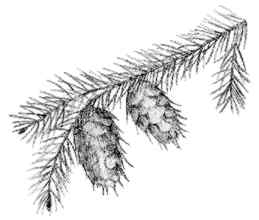 [Fig.
17(1)] Wildflowers and granite are at play along this trail. This is
a rugged day hike, but well worth the views in this glacially influenced
landscape just north of the Granite Chief Wilderness.
[Fig.
17(1)] Wildflowers and granite are at play along this trail. This is
a rugged day hike, but well worth the views in this glacially influenced
landscape just north of the Granite Chief Wilderness.
The sights include the headwaters of the North Fork American River, Granite Chief Peak, and even Lake Tahoe. Hikers might want to think about camping a night to take it all in. Otherwise, it is a full day of hiking.
Campers along this and many other Northern Sierra trails have reported being startled on summer evenings by a huge, brown beetle. The spiny woodborer or pine sawyer (Ergates spiculates), one of the largest beetles in the West, will fly directly into flashlights, lanterns, and other lights. At 2 inches long, the beetle makes some people feel as though they've been struck by a rock.
Along with the eyed elater (Alaus melanops), another big beetle, the spiny woodborer, can do a lot of tree damage. The eggs that these two beetles lay in the crevices of such trees as the Douglas fir (Pseudotsuga menziesii) can hatch into larvae that chew into the wood.
Read and add comments about this page